Have you ever wondered how app monetization works? The simple answer is choosing the right app monetization strategy. Mobile app monetization strategies play a key role in your app’s success. They can truly make or break how well your app performs in the market. We see so many mobile applications that have thousands of downloads, but still, they struggle to generate sufficient revenue. The common reason most of the time is poor app monetization strategies.
You would be stunned to know that the global consumer spending on applications has hit the $150 billion mark in 2024. And if we talk about the total global revenue of apps, it has reached approximately $390 billion, indicating how much revenue a well-planned app can generate.
Almost all apps offer free versions, and app developers have to rely on an excellent app monetization strategy in order to survive because of limited resources. As of September 2025, the situation was as follows: the App Store had around 95.37% of all iOS applications available for free, and the Google Play Store had a whopping 96.99% of its apps at no charge.
Nowadays, people use their phones for more than five hours daily, and almost 90% of that time is spent on apps. This is a huge chance for app developers, but a challenge as well. For any mobile app development company, a beautifully designed app is just the beginning. The actual challenge starts post-launch when the app development team has to come up with ways to convert all that user engagement into consistent and dependable earnings through smart mobile app monetization strategies.
This mobile app monetization guide is going to reveal the concept of revenue generation from apps, how to measure app monetization success, debate the importance more than ever before, and show the app monetization strategies commonly implemented by a leading app development company.
CTA SECTION START
cta title: Looking to turn your app into a steady revenue stream?
cta des: Talk to our experts at Inceptives Digital and get a tailored monetization plan.
cta button: Let’s Connect
CTA SECTION END
What Is App Monetization?
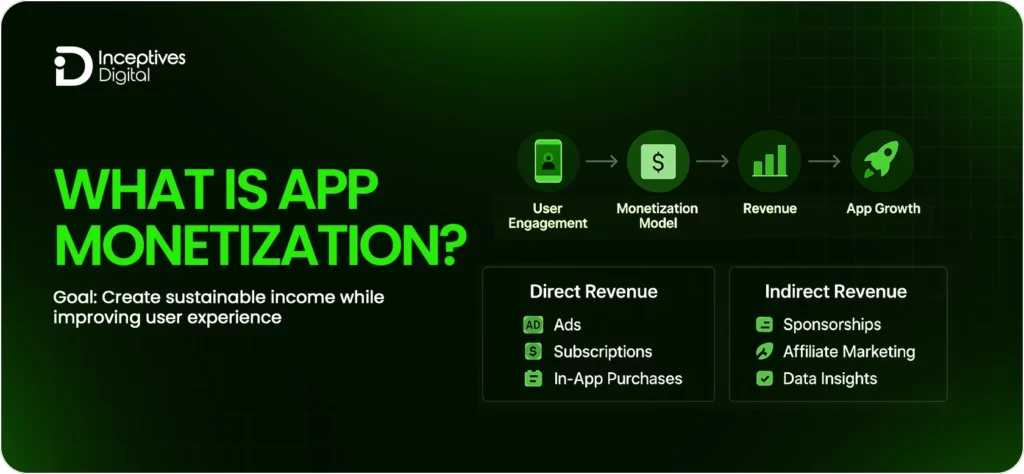
App monetization is the method by which a mobile application is able to generate income. It is the process that converts user participation, the amount of time spent, users’ actions, and the app’s features accessed into measurable mobile app revenue generation.
Straightforwardly, it is the method companies make money from their applications without necessarily imposing charges on the users right away. A good monetization strategy is the link between the growth of your mobile app and its revenue, whether it has only a couple of hundred users or millions.
There are multiple ways to do that. Displaying advertisements, providing premium subscriptions, selling in-app products, or partnering with other companies for shared interests are the most frequent methods used.
The fundamental aspect of successful monetization is to maintain a balance, to provide value to users, and at the same time make your app profitable and scalable.
Here’s how does app monetization works:
- Direct revenue: Ads, subscriptions, and in-app purchases
- Indirect revenue: Sponsorships, affiliate marketing, and data insights
- Goal: Create sustainable income while improving user experience
To sum up, app monetization is not only about taking money. It is a matter of creating a business model that will keep your app thriving for a long time.
Why Well-Planned App Monetization Strategies Matter?
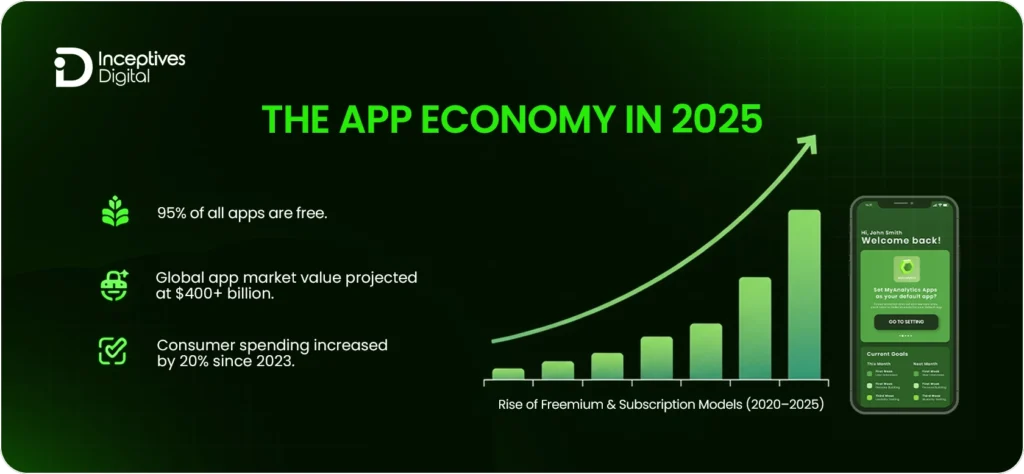
The mobile app market has reached an unprecedented level of both competition and profitability. By the year 2025, it is forecasted that the total consumer spending on mobile apps worldwide will go over $190 billion, and this will mainly be the result of gaming, entertainment, and subscription services. The dramatic increase in mobile app spending underlines one very straightforward fact: apps that fail to monetize their users effectively are going to lose their market positions, irrespective of the number of downloads they have.
More than 95% of apps are free, so install-based revenue is no longer the method of earning for app development companies. They now depend on innovative and sustainable app monetization ways to bring in continuous revenue. Models of this kind are not only about revenue. But they are the factors behind the operation of apps, their scalability and competitiveness in the fast-moving ecosystem of today. Below are the three major reasons that make effective app monetization a necessity for applications.
1. Evolving User Spending Behavior
There has been a radical change in user habits. Consumers are willing to pay for apps that offer convenience and value, such as streaming, fitness, and productivity platforms. This change in users’ behavior has turned app monetization into a necessity. Nowadays, companies are less concerned with paywalls and more with engagement-based revenue like microtransactions or value-added subscriptions.
2. The Decline of Paid Apps and the Rise of Freemium Models
Paid applications are becoming rare. The users’ primary wish is to have free access first and then to pay for better features or for an ad-free experience. The freemium habit is a major factor in the mobile app industry of 2025, and it allows developers to bring in users without the upfront barrier and still get long-term app revenue.
3. How Smart Monetization Boosts User Retention and ROI?
Retention is also a factor that plays a vital role in effective monetization. Users stay longer and spend more when they believe that they are receiving value through exclusive content, personalized offers, or fair pricing. The smart app monetization methods do not disturb the experience; on the contrary, they improve it, thus fostering loyalty among customers and increasing the ROI.
To sum it up, mobile app monetization in 2025 has become a survival strategy rather than a mere revenue tactic. The apps that excel at this will not only be visible and grow to a larger size faster, but also provide such experiences that both users and businesses will continue to grow.
CTA SECTION START
cta title: Don’t let your app downloads go to waste.
cta des: Let Inceptives Digital help you build a monetization strategy that actually drives revenue.
cta button: Let’s Connect
CTA SECTION END
How to Choose the Right App Monetization Model?
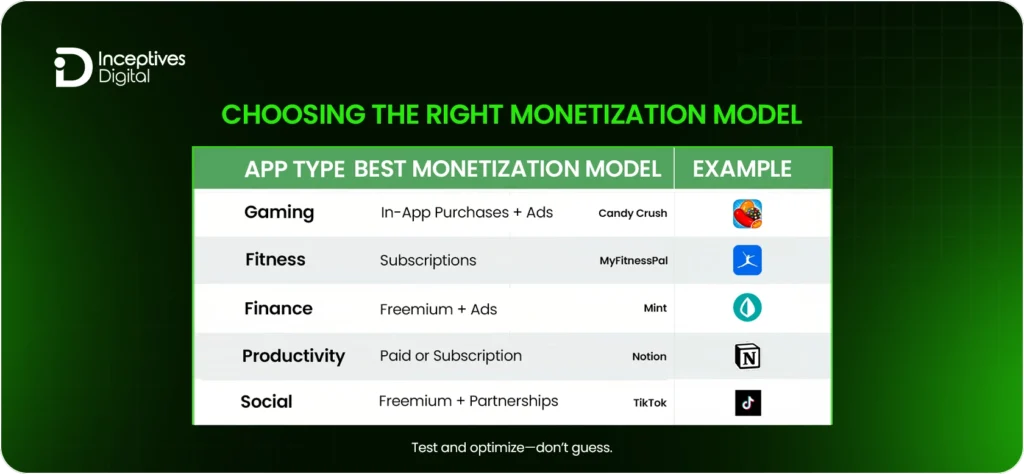
One of the most important decisions after the launch of your app is choosing the right app monetization model. There is no universal app monetization strategy that works for every app. What works for one app may not work for others. For example, a strategy that works for a fitness app may not work for a fintech application. You have to determine who your target audience is, their behaviour, and design a custom app monetization strategy that seems natural and profitable.
Key Factors That Influence Monetization Decisions
Here are the factors that can affect your app monetization strategies:
- App Type: There is a possibility that the model applied to a gaming app (such as in-app purchases) may not be appropriate for a finance app, which may get more advantage from the subscription or freemium access method.
- Audience Demographics and Location: Different regions have different spending habits. Like North American users might go for a subscription model, while users in emerging markets could be more inclined towards ad-supported models.
- User Engagement Levels: Highly active users open more opportunities for in-app purchases and ads, while occasional users might respond better to simple, freemium access.
- Platform (Android vs. iOS): iOS applications are more likely to generate bigger payments when it comes to purchases and subscriptions. On the other hand, Android applications usually generate higher revenues through ads.
- Monetization Goals: Choose between fast user growth and steady revenue as your main goal. A freemium or ad-supported income stream can lead to quicker scaling, while subscriptions ensure a stable and long-lasting source of income.
Best App Monetization Strategy by App Type
| App Type | Best Monetization Model | Why It Works |
| Gaming | In-App Purchases + Rewarded Ads | Motivates users to be active by granting gameplay rewards and adding new features. |
| Fitness & Wellness | Subscription Model | Keeps the customers interested by introducing workouts, tracking of performance, and providing premium content. |
| Finance & Investment | Freemium + Subscription | Establishes reliability via free instruments and subsequently transfers the committed users to the paid plans. |
| E-commerce | Affiliate Marketing + In-App Ads | Seeks revenue streams via product endorsing and collaborations. |
| Education & Learning | Freemium + Subscription | Allows learners to access the essential lessons without any charges, while advanced content is available at paid levels. |
| Productivity & Tools | Paid or Freemium | Justifies price with extraordinary functionalities or experiences without advertisements. |
| Social & Lifestyle | Ads + Sponsored Content | Utilize huge user bases for advertising income and brand partnerships. |
Why Test, Measure, and Optimize Your App Monetization Model?
There is no single “best app revenue strategy” that applies to all. What is effective for one application may not be the same for another app, even if they are in the same category. It is crucial to implement various models, carry out real-time data analysis, and adapt according to customer feedback and performance metrics.
Constant A/B testing, audience segmentation, and user retention monitoring will assist you in perfecting your app monetization model to get the right mix of profit and user experience.
Proven Mobile App Monetization Strategies
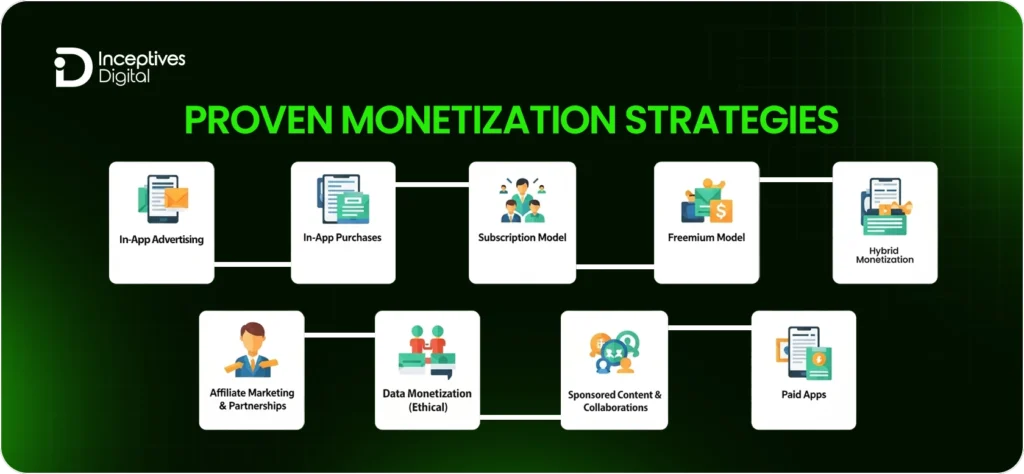
The success of an app is not just the thousands of downloads it has, but it is finding a smart way to generate a handsome amount of revenue from it. Below, we have listed the 9 best mobile app monetization strategies that are very common in the mobile app development industry:
1. In-App Advertising
Understanding how to monetize mobile apps with in-app advertising starts with choosing the right ad formats and balance. It still is the most popular method for monetizing free apps. Ads can take several forms:
- Banner ads: Small and non-intrusive.
- Interstitial ads: Full-screen during natural breaks.
- Native ads: Blend with app content.
- Rewarded video ads: Offer in-app rewards for views.
It is advisable to use ad mediation tools and limit the frequency of ads to ensure a good user experience. The gaming applications often use rewarded ads as a technique to keep users engaged and, at the same time, earn extra money from ads.
2. In-App Purchases (IAP)
To understand how to monetize mobile apps with in-app purchases, simply give users the option of purchasing digital products, advanced features, or even subscriptions in the app. This means the app is generating revenue continuously.
Types include:
- Consumables: Coins, lives, or tokens.
- Non-consumables: Permanent unlocks.
- Subscriptions: Recurring payments for premium features.
Mobile games mainly get a boost in conversions through personalized offers and virtual currency.
3. Subscription Model
Many people often ask, “What is the subscription model for apps?” In simple terms, it is a monetization method that generates consistent and recurring income from the app, either monthly or annually. Apps that continuously provide value, like fitness, education, or streaming, are the ones that this model is best suited for.
Applications such as Calm and Duolingo Plus are very successful in using the strategies of giving free trials and having different plans. If you want to retain the users, you have to do regular updates to features and content.
4. Freemium Model
The freemium model first attracts a large user base by giving free access, and then it slowly converts active users to paid plans by offering premium features. That is the simple answer to the common question: What is the freemium model in apps?
Giving examples like Spotify and Canva, free tools can create a bond of trust while exclusive upgrades spur conversions. Keeping a healthy balance between free and paid features will help you engage the users.
5. Hybrid Monetization
A hybrid monetization model incorporates several methods, such as advertisements and in-app purchases, to secure a more diversified income.
This model has the advantage of being adaptable and suits the gaming industry perfectly. However, if there are too many monetization layers, it might lead to user fatigue, so the right amount is very important.
6. Affiliate Marketing & Partnerships
Apps can receive a commission via affiliate programs whenever they advertise third-party products or services. This is mainly applicable for travel, finance, or lifestyle apps.
Partnerships should always be disclosed and their relevance checked. For example, a travel app that connects to hotel or flight booking sites earns through referral links while providing users with added value.
7. Data Monetization (Ethical Approach)
Data monetization involves the conversion of anonymized analytics reports and the like into market insights or reports via GDPR and CCPA compliance.
The app can sell the market insights or trend data, but the user privacy compliance and the consent issue are very important in building and maintaining trust.
8. Sponsored Content & Brand Collaborations
The brands that have sponsored partnerships pay for visibility and co-branded campaigns. It is very effective for media, news, or fitness apps.
Think of native sponsorships that really match the brand, like a fitness app working with a sportswear brand for challenges or tutorials.
9. Paid Apps
One question that often arises among app owners is, paid apps vs free-to-download apps, which is better? The answer will vary according to your audience and the business objectives.
Paid apps require users to pay an amount rather than a subscription, and can still be applied to niche or B2B tools that users prefer due to their premium quality.
They generate upfront revenue with a premium image but normally have fewer installations. Productivity or design apps frequently adopt this paid app model successfully.
CTA SECTION START
cta title: Not sure which strategy fits your app best?
cta des: Schedule a free consultation with our team, and we’ll guide you through the best approach for your app type and audience.
cta button: Let’s Connect
CTA SECTION END
Mistakes To Avoid While Implementing An App Monetization Strategy
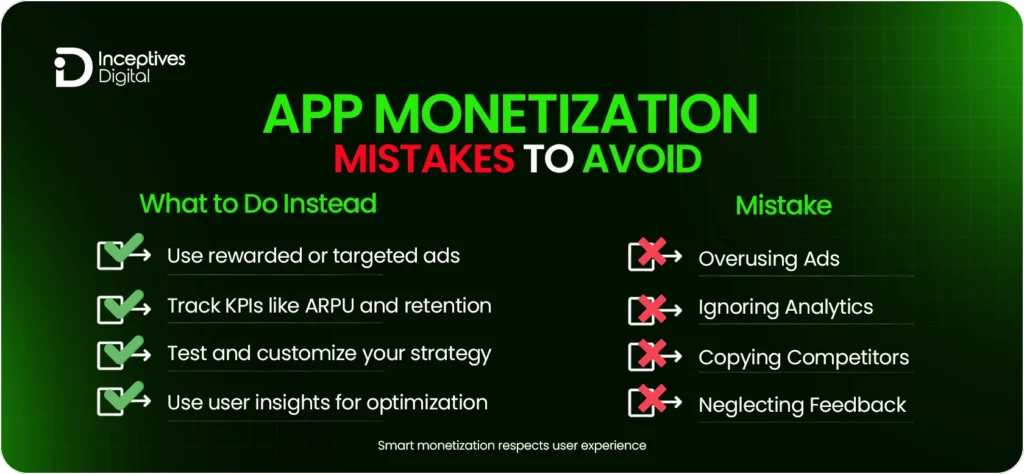
The most amazing applications can still experience drops in revenue if their app monetization strategies are not properly managed. Below are some of the typical errors concerning app monetization, together with good advice on how to optimize your app monetization strategy.
1. Overusing Ads or Interrupting UX
Users can be easily aggravated and lost as a result of excessive advertising or poorly situated ads.
What to do instead: Use a small number of excellent ads that fit the user’s behavior. Rewarded or native formats should be the main focus to keep the experience pleasant while still making revenue.
2. Ignoring Analytics and A/B Testing
Bypassing analytics results in a loss of important insights into user behavior and revenue performance.
What to do instead: Monitor metrics related to engagement, conversions, and retention. Conduct A/B tests to determine which placements or features are the most effective and to make adjustments based on actual data.
3. Copying Competitor Models Blindly
The monetization strategies that are successful with one application are not necessarily the same with another. Simply copying the monetization models without getting to know the audience can really limit the outcome.
The better approach is: Analyze your user base, niche, and traffic patterns. Instead of imitating, create a strategy that goes well with the value of your app and the preferences of the audience.
4. Neglecting Feedback and Retention Metrics
The focus on short-term revenue only can be detrimental to long-term growth. The neglect of user feedback usually results in low retention and negative reviews.
The alternative is: Motivate users to give feedback, monitor churn rates, and adjust your method in such a way that a positive loop is created between user satisfaction and revenue growth.
Steering clear of these missteps keeps your app monetization strategy long-lasting and more friendly to users. The aim is not merely to increase revenue. It is to create sustainable value for your company and your customers over time.
CTA SECTION START
cta title: Are you getting high quotes?
cta des: Avoid costly mistakes with expert guidance. Partner with Inceptives Digital to set up a monetization model that actually works.
cta button: Let’s Connect
CTA SECTION END
How to Track and Optimize Your Monetization Performance?

The selection of a revenue model is not the end of monetization. The actual growth starts with monitoring your performance. One of the main queries by app owners is, What are the best practices for app monetization? The process goes on by constantly monitoring the appropriate metrics and experimenting with your strategy.
Key Metrics to Watch
- ARPU (Average Revenue Per User): Tells how much, on average, each user contributes to the revenue.
- Retention Rate: Counts the number of users who come back after they have downloaded your app.
- Conversion Rate: Measures the success of the free-to-paid user transition.
- eCPM (Effective Cost Per Mille): Serves as an indicator of the ad performance per 1,000 impressions.
Keeping an eye on these monetization metrics puts you in a position to detect revenue increase opportunities that do not impair the user experience.
Useful Tools for Insights
Platforms such as Firebase, App Annie, Adjust, and Mixpanel facilitate the gathering and illustration of performance data. Make use of them to gain insights into user actions, monitor advertising revenue, and perform experiments with price or location.
Test and Refine Constantly
To upgrade the system, there is nothing more helpful than constant A/B testing. The advertisement, pricing plans, and feature roles should be experimented with in order to find the one that gives the best results. Even minor changes can have a significant impact if they are supported by the analysis.
CTA SECTION START
cta title: Ready to optimize your app’s performance?
cta des: Our analytics-driven approach helps you track every dollar your app earns.
cta button: Let’s Connect
CTA SECTION END
Future Trends in App Monetization
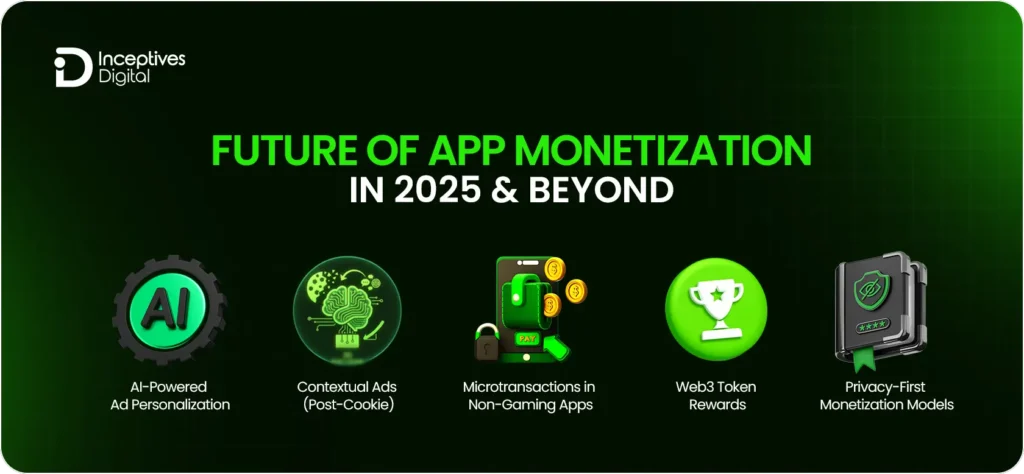
The mobile app economy keeps on changing, and alongside that, the methods developers use to monetize their applications are also changing. New technologies and customer requirements are influencing the future of app revenue in 2025.
AI-Powered Personalization
The use of artificial intelligence in ad targeting has been nothing short of radical. Through AI personalization and predictive modeling, an app is able to show relevant and beneficial ads instead of being annoying to the user. This results in higher user engagement and conversion rates while the user experience remains pleasant.
Contextual Ads Over Cookies
With the coming of stricter privacy laws, contextual advertising has taken over cookie-based targeting. Now, ads are displayed according to in-app audience behavior and content instead of personal information, making it possible for the brands to comply with laws and, at the same time, retain the effectiveness of the ad.
Microtransactions and Gamification
It seems that non-gaming applications are getting inspired by gaming’s strategies. Be ready to see a lot of microtransactions, tiny, very easy to make purchases, and gamified systems that offer rewards for involvement and loyalty.
Web3 and Tokenized Economies
New revenue streams are being unlocked by the implementation of Web3 and blockchain development. Apps are discovering new and creative ways to make money through tokens that provide users with ownership and visibility, such as token-based loyalty programs and decentralized marketplaces.
Privacy-First Monetization
People have become very conscious about their privacy, and many of them now understand what are the different app monetization models. Privacy-first app monetization models which are where users’ data is either anonymized or controlled by the user, will get noticed and create a long-term trust bond.
To sum up, the app monetization trends in 2025 will be mainly concerned with personalization, compliance, and user empowerment, which are the three powerful forces that will determine the next generation of mobile revenue strategies.
CTA SECTION START
cta title: Stay Ahead of the Curve
cta des: Inceptives Digital builds next-gen monetization solutions aligned with 2025’s app trends.
cta button: Let’s Connect
CTA SECTION END
Case Studies: Apps That Nailed Monetization
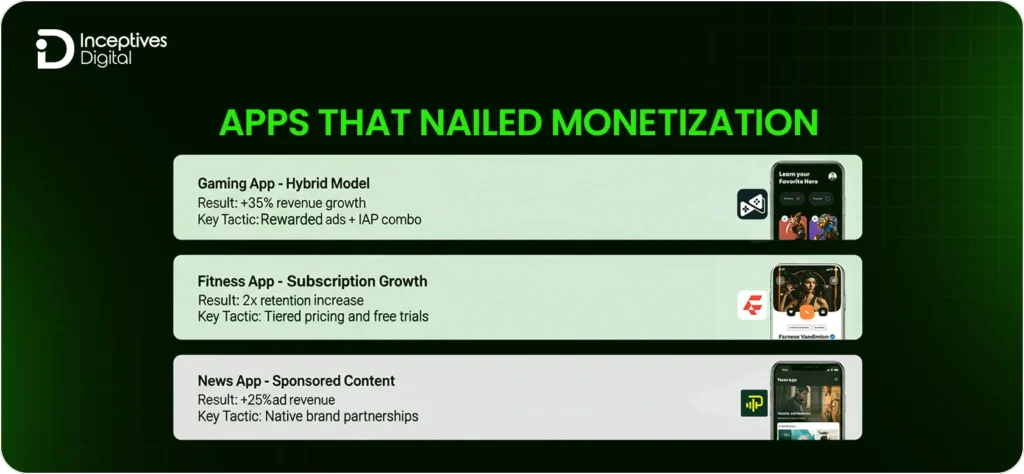
Often, real-world scenarios reveal what data cannot show. These applications are proof that app monetization strategies based on engagement can turn revenue into consistency.
1. Candy Crush Saga – Hybrid Model Mastery
Candy Crush Saga is utilizing a hybrid model where users have the option to either pay for in-game perks and extra lives or watch ads to get rewards. This mixed strategy not only allowed the app to cross the mark of $1 billion annual revenue but also made it the top mobile game by revenue in the world.
Lesson: Increase customer retention and profit by introducing different varieties of ads, optional ads, and fair purchases.
2. Calm – Subscription-Driven Success
Calm constructed its model on freemium subscriptions, allowing users access to free basic features and then offering premium upgrades. The company’s commitment to providing uninterrupted value transformed it into a brand with a recurring revenue of one hundred million dollars.
Lesson: Always keep users hooked with personalized and changing content.
3. The New York Times App – Native Ads That Work
The NYT app integrates both sponsored and native ads seamlessly into its editorial experience and thus generates more than $300 million in digitized ad revenues annually.
Lesson: Understated but relevant advertising gets and gives trust and thus generates income that can last for a long time.
Key Insights from Successful App Monetization Examples
| App | Monetization Model | Key Strategy | Outcome | Core Insight |
| Candy Crush Saga | Hybrid (Ads + IAP) | Rewarded ads and optional purchases | $1B+ annual revenue | Balance user choice with revenue options |
| Calm | Freemium Subscription | Free basic access with paid premium features | High recurring revenue | Continuous value keeps users subscribed |
| The New York Times | Native Advertising | Sponsored articles matching editorial tone | $300M+ in ad revenue | Relevance and authenticity drive trust |
How to Start Monetizing Your App (Step-by-Step Guide)
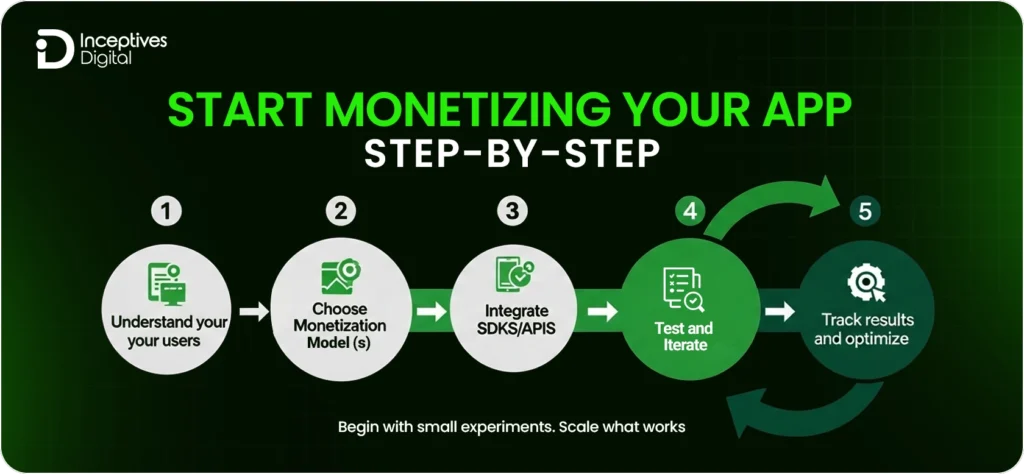
If you are prepared to convert your application into a revenue source, the method will begin with an app monetization plan and finish with its refinement. Here is an easy app monetization guide to help you proceed correctly.
Step 1: Understand Your Users
Before the monetization process begins, it is important to know the users and their values. Investigate the user behavior, demographics, and in-app activity to find out the common traits. This knowledge will allow you to select the monetization models that won’t be felt as forced, but rather as a natural fit.
Step 2: Choose the Right Monetization Model
Different apps have different features. It is up to you to see which way is best for your audience and category. Ads, subscriptions, in-app purchases, or a hybrid model. Don’t simply imitate what others do; concentrate on what suits your user experience the best. We will suggest collaborating with an app development company for better results. Click to see how to choose the right app development company.
Step 3: Integrate SDKs or APIs
After picking a model, you should link it with trustworthy SDKs or APIs. One possible scenario is using Google AdMob or Facebook Audience Network for ads and Stripe for subscriptions. A smooth integration guarantees a steady performance and correct tracking.
Step 4: Test and Refine Your Approach
Test various positions, pricing, or ad rates through A/B experiments. Get data, pay attention to what people say, and improve the parts that are not effective. App monetization is not just one setup. It is a continuous process of trying out different methods.
Step 5: Track and Optimize for Growth
Keep an eye on important indicators like ARPU (Average Revenue Per User), conversion rates, and retention. Analyze the performance and make improvements based on data using tools like Firebase, Adjust, or App Annie.
Turn Your App into a Profitable Asset

App monetization is more than just putting up ads or implementing subscriptions. It means developing a model that is suitable for your customers and also expands with your business. When executed properly, it transforms the engagement into a steady flow of money.
To start, you should have a thorough understanding of your audience, experiment with various methods, and monitor the results. Continue to make small refinements, as minor adjustments frequently result in significant advances.
If you are in need of a professional, our mobile app development company will be happy to assist you in the areas of strategy, design, and growth. Our main objective is to develop custom software that not only draws the users in but also provides a steady income source.
CTA SECTION START
cta title: It’s time to put your app to work.
cta des: Contact Inceptives Digital today and start turning downloads into dependable revenue.
cta button: Let’s Connect
CTA SECTION END
FAQs About App Monetization
Free apps make money through various ways, such as in-app ads, affiliate marketing, or selling upgraded features. They also provide subscriptions to, or sell digital items to, users who are highly engaged.
There is no such thing as a universal solution. Startups usually start with a freemium or ad-supported model to pull in the customers, then later on, they launch subscriptions or in-app purchases along with heightened engagement.
The first step is to prioritize user experience. Implement personalized and soft ad placements, consider rewarded ads, and conduct Ongoing A/B testing on ad formats for regular ads.
Subscriptions provide a consistent stream of income, whereas in-app purchases are more flexible and lead to quicker sales. The right one for you will depend on your app’s nature and the frequency of the user’s interaction.
Other options besides ads include subscriptions, affiliate marketing, and sponsored content as revenue sources. Some partner with other companies, while others sell anonymized insights ethically, and thus, still manage to keep their apps profitable.
SIDEBAR LIST START
- Introduction
- What Is App Monetization?
- Why App Monetization Matters in 2025
- Proven Mobile App Monetization Strategies
- App Monetization Mistakes to Avoid
- How to Track and Optimize Your Monetization Performance
- Emerging Trends in App Monetization
- Case Studies: Apps That Nailed Monetization
- How to Start Monetizing Your App (Step-by-Step Guide)
- Conclusion
- FAQs
SIDEBAR LIST END